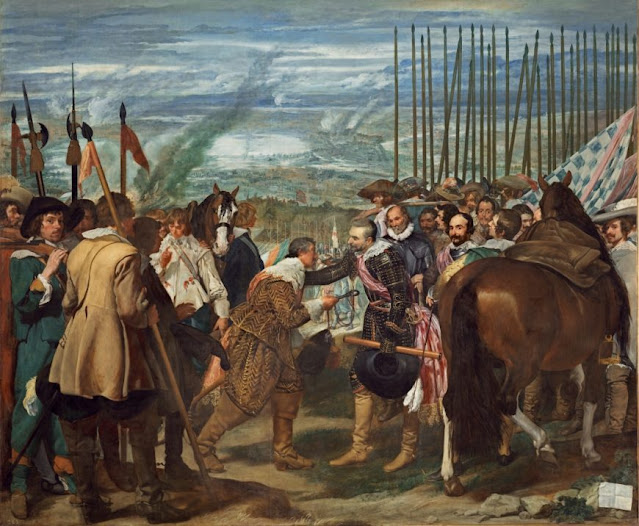Baroque: The Surrender of Breda
The Surrender of Breda:
I chose to analyze an oil painting, The Surrender of Breda, which was either painted in 1634 or 1635 by Diego Velȧzquez. I enjoy this oil painting because it is realistic and because it has several different aspects to it. There is not only a lot of history in this painting but there are also a lot of things that portray meaning. The Eighty Years' War was a long battle that the Dutch fought to gain independence from Spain (Tikkanen). Amidst this long war, Spain ended up capturing the city of Breda, forcing the Dutch to surrender, as you see in the painting (Dios). This painting was completed by one of the best court painters of King Philip IV, Diego Velȧzquez, who depicted the Dutch, as they surrendered to Spain. It can be seen in the middle of the painting, that the Dutch commander, Justinus van Nassau, is giving the key to the city to Ambrogio Spinola, who was the captain of the Spanish army at that time (Dios).
Lines
Diego Velȧzquez uses a number of different lines to convey different feelings. Vertical lines are used in paintings, to convey strength and height, which is exactly what Velȧzquez was able to do. The spears are made up of vertical lines, which is used to show that the armies are strong. There are a number of spears that are set behind the Spanish, which can be interpreted by more of the Spanish soldiers, who are holding their spears upright. This can give us the sense that the Spanish are strong. Some of the Dutch soldiers have spears, but they are not being held up as high, or as straight. This can be used to show that the Dutch army is also strong, but that they are not as strong as the Spanish. The vertical spears in the painting are also used to show that the soldiers are high on a mountain, located above the rest of the landscape that can be seen in the background.
The painter also used a big horizontal line in the background of his painting. There is a horizontal line in the painting, where the land ends, and where the clouds begin. This horizontal line is there to show that there is a lot of space and distance incorporated into the painting. It is used to show that the land located near the top of the painting is far away, and that we are looking at a broad piece of land. Horizontal lines are often times used to show distance, which is exactly what the horizontal line is being used for in this painting.
Diego Velȧzquez uses lines on Nassau's and Spinola's clothing, to express how they feel. The Dutch commander, Justinus van Nassau is dressed in a shirt that has a lot of jagged lines on it, whereas the Spanish captain, Ambrogio Spinola, has a number of curved lines on his armor. This is representational, because jagged lines convey anxiety and turmoil, while curved lines convey comfort and ease. This makes sense, because Nassau is feeling anxious, since his army, and his people just lost an entire city. Spinola's armor was depicted to have curved lines, because he probably felt like he would be able to relax for a little bit, since he and his army just finished taking over a city. He would feel like life would become easier and more comfortable.
Shape
Diego Velȧzquez uses shapes in his painting to convey different feelings. One of the Spanish soldiers is waving a flag around, which is made up of a checkered design of white and blue squares. The flag is made up of a bunch of squares, so that we can sense that the Spanish army is strong. This is because squares are used to represent strength and stability.
Color
Diego Velȧzquez uses color in his oil painting, to make things look more realistic, and to create form. He uses white on Ambrogio Spinola's left shoulder, so that we can see that there is light being reflecting off of his shoulder. This can help us to know that he is wearing a shiny piece of armor, made of metal. This can also help us to see that there is a third dimension to the painting. The shine on the armor, can help us to realize that the armor is round, and that it is three dimensional. The light is only reflecting off of the armor, in the one spot, which means that it is the only spot that is facing the sun directly.
The Influence of Royalty
The Surrender of Breda was influenced by royalty, because the king had Diego Velȧzquez create the painting. It is explained by joyofmuseums.com, that King "Philip IV of Spain commissioned the painting for his palace of Buen Retiro." It is further explained that the king had the painting made, to be displayed in his palace to glorify the military accomplishments of Spain, where 19 other paintings had been displayed.
The painting, The Surrender of Breda, by Diego Velȧzquez is a huge painting, that is about 10.08 feet by 12 feet, which can be found displayed at the Prado Museum. There have been smaller copies made of the painting though, that anyone can buy. I find the painting to be pretty cool and interesting, but I would not want to own a copy for myself, because it is not one of my favorite pieces of art.
References
Britannica, The Editors of Encyclopaedia. “Eighty Years' War.” Encyclopædia Britannica, Encyclopædia Britannica, 29 Feb. 2016, https://www.britannica.com/event/Eighty-Years-War.
Dr. Jimena Berzal de Dios. “Diego Velázquez, the Surrender of Breda.” Smarthistory, 8 Aug. 2015, https://smarthistory.org/velazquez-the-surrender-of-breda/.
“‘The Surrender of Breda’ by Diego Velázquez.” Joy of Museums Virtual Tours, 8 Oct. 2020, https://joyofmuseums.com/museums/europe/spain-museums/madrid-museums/prado-museum-museo-del-prado/the-surrender-of-breda-by-diego-velazquez/.




Comments
Post a Comment